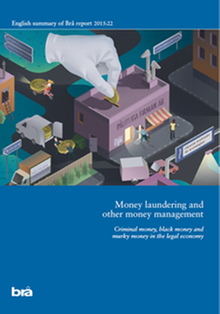- Start
- / Home
- / Publications

Money laundering and other money management
Criminal money, black money and murky money in the legal economy. English summary of Brå report 2015:22
The greatest volumes of illegal money appear in economic crimes. Greater focus may thus be placed on combatting economic crimes, verifying cash flows within the financial system, and investigating where this money goes.
Money laundering is a complicated concept. The words “money laundering” customarily refer to measures to conceal financial gains from criminality, i.e. to convert black or criminal money to clean money. There are, however, offences where the criminal financial gains do not need to be “laundered”. One example is when clean money is made black in order to make it possible to withdraw it from the company to finance undeclared work. In respect of environmental offences and the violation of other rules which regulate businesses, no special measures are necessary to conceal gains from “saved” costs since such gains can instead be treated as profit or paid out as wages (so-called “murky money”).
Brå has been instructed by the Government to investigate the circumstances surrounding, and methods used for, money laundering in Sweden. The overall purpose of the mandate is to identify central sectors in which a particularly significant amount of money laundering occurs and to assess the risks within such sectors. The mandate also includes surveying money laundering methods, analysing international aspects, presenting projections for the future, and suggesting ways to combat money laundering.
© The Swedish National Council for Crime Prevention, 2016
Authors: Anna Horgby, Daniel Särnqvist and Lars Korsell
urn:nbn:se:bra-644

